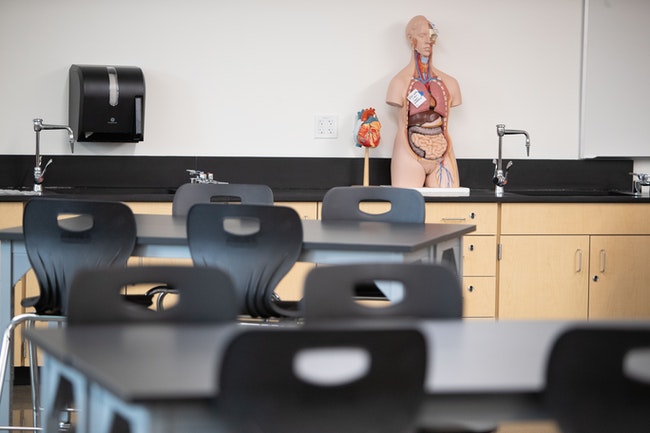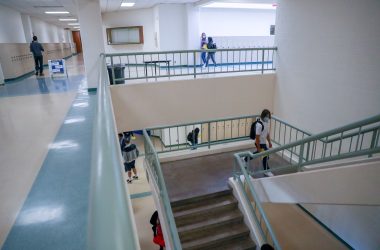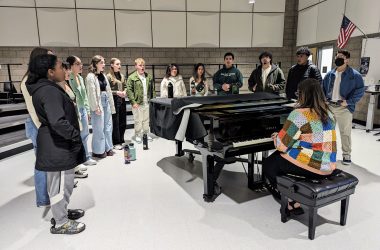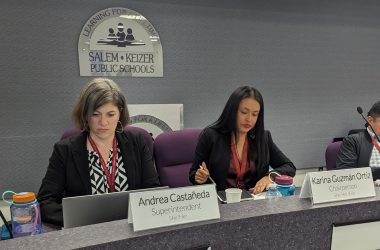 A science classroom in at McKay High School (Amanda Loman/Salem Reporter)
A science classroom in at McKay High School (Amanda Loman/Salem Reporter)
When the end of lunch bell rings at McKay High School, Ranae Quiring starts making the rounds.
The principal of Salem’s largest high school said she usually has a few tables of students who seem to miss the normal cues that it’s time to put their phones away and go to class.
She’ll offer a gentle reminder to move them along.
“As soon as they see me coming they know exactly what I’m going to ask: ‘Hi, do you have a fourth period class?’” she said.
Quiring said it’s one example of how some students have struggled to return to normal school routines as district high schools resumed full time, in-person classes this fall following over a year of mostly online school.
“They wouldn’t even be aware that the bell had rung,” Quiring said. “They were sort of back in (online school) land where they weren’t really accountable to a person.”
Those adjustments, she said, are the main challenge educators face as they try to help students get on track academically.
After one semester back, Salem-Keizer School District data shows the number of failing grades given to high schoolers was down slightly compared to the previous school year, but still higher than before the pandemic.
Though local high schools have expanded credit recovery programs to help students who failed courses last year catch up, data shows so far they’ve done little to move the needle for the current sophomore class.
Districtwide, high schoolers were graded on 83,000 courses during first semester, which ended in mid-January. About 15% of those grades were failing.
That’s lower than the F rate during online school, which was about 20% last spring. But it remains above the 10% fail rate local students posted during the first semester of the 2019-20 school year – the last “normal” grading period before the pandemic.
Class failure rates were highest at McKay, where 19% of the school’s 15,290 grades were Fs, and North, where 22% of 14,439 grades were failing. Both schools are Title I schools, a federal designation meaning a high percentage of students live below the poverty line.
(Graphic by Rachel Alexander/Salem Reporter)
Salem’s Early College High School and alternative Roberts High School, as well as the online EDGE program, grade on a trimester system. Of the 4,065 high school grades given first trimester at those schools, 22% were failing, district data shows.
The Class of 2024, currently sophomores in high school, has particularly struggled.
After completing freshman year online, just 70% of district students were considered on-track to graduate in four years, according to state data released in October.
The state measure tracks whether freshmen have completed six credits – one-quarter of what’s needed to earn a diploma. Pre-pandemic, the district had about 85% of its freshman class on track.
“Our sophomores are having their very first year in high school since they’ve been middle schoolers,” Quiring said. Educators have spent much of this school year helping students establish routines and expectations, getting students used to the idea that in high school, their grades matter.
“We’ve had many students at McKay being very successful, but we’ve had a larger number of students not wanting to be students or behave like students,” Quiring said.
In addition to the drop, data shows inequities widened for students. Latino and Pacific Islander students, who already graduate at lower rates than their white peers, saw larger drops in readiness. So did migrant and homeless students.
With another semester of high school done for the Class of 2024, district data requested by Salem Reporter shows those numbers haven’t moved much. Just 70.8% of the class had completed at least nine of the required 24 credits for an Oregon diploma by the end of first semester.
 Instructional assistant Jessica Braun sorts student schedules on the first day of school at North Salem High School on Wednesday, Sept. 8, 2021. (Amanda Loman/Salem Reporter)
Instructional assistant Jessica Braun sorts student schedules on the first day of school at North Salem High School on Wednesday, Sept. 8, 2021. (Amanda Loman/Salem Reporter)
Larry Ramirez, the district’s high school director, said the grades are “definitely an improvement from where we were online,” but not where educators want to see them.
He said high schools around the district are tweaking credit recovery options to make it easier for students who fall behind to earn a passing grade for a course. Rather than re-take an entire class, he said schools increasingly offer an elective period where students behind in multiple subjects can complete only the work they failed when taking a class the first time, which allows them to catch up more quickly.
But progress has been slower than school leaders would like as they’ve worked to convince some students to come back to school at all.
“We obviously still haven’t got enough (students) to get in there to retrieve that credit,” Ramirez said, referencing the district data for those on-track to graduate.
More schools are offering Saturday options too, but Ramirez said that’s not an easy sell for those already struggling weekdays.
“It’s hard to get a kid to come to Saturday school that didn’t come to school Monday through Friday very well,” he said.
Quiring and Chad Towe, principal at North Salem High School, said they’re seeing progress over the first weeks of second semester as students have gradually adjusted to being back.
Attendance rates have improved, helped by the waning of the omicron surge which kept many students and teachers home sick. Students are starting to re-learn how to be students.
At North, Towe said the school is trying a number of strategies to help students catch up. Just 58% of the school’s sophomore class was on track to graduate at the end of the first semester.
The school now offers tutoring daily after school in English and Spanish.
He’s added a half-time worker to review standards across classes and help standardize so that each section of freshman biology covers the same topics, regardless of who’s teaching it. That makes it easier to pinpoint which skills a student is missing if they fail a course and need to make up the work.
“If a student fails one of those classes, we know exactly what we failed,” he said.
He’s worked to hire teachers with experience in middle schools who can more easily relate to students who in many ways still feel younger than they are.
“They would have had their last year in school as eighth graders. There’s a lot to adjust to when you come to a comprehensive high school,” Towe said.
He’s closely monitoring more than a dozen data points showing how students are doing at North, both for the student body as a whole, and for groups including those learning English and students with disabilities.
Contact reporter Rachel Alexander: [email protected] or 503-575-1241.
JUST THE FACTS, FOR SALEM – We report on your community with care and depth, fairness and accuracy. Get local news that matters to you. Subscribe to Salem Reporter starting at $5 a month. Click I want to subscribe!









